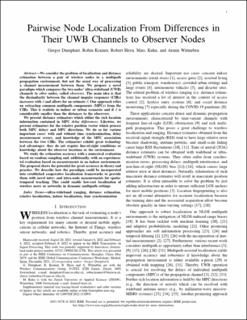Please use this identifier to cite or link to this item:
https://doi.org/10.21256/zhaw-24298Full metadata record
| DC Field | Value | Language |
|---|---|---|
| dc.contributor.author | Dumphart, Gregor | - |
| dc.contributor.author | Kramer, Robin | - |
| dc.contributor.author | Heyn, Robert | - |
| dc.contributor.author | Kuhn, Marc | - |
| dc.contributor.author | Wittneben, Armin | - |
| dc.date.accessioned | 2022-03-01T08:15:37Z | - |
| dc.date.available | 2022-03-01T08:15:37Z | - |
| dc.date.issued | 2022-02 | - |
| dc.identifier.issn | 1053-587X | de_CH |
| dc.identifier.issn | 1941-0476 | de_CH |
| dc.identifier.uri | https://digitalcollection.zhaw.ch/handle/11475/24298 | - |
| dc.description | © 2022 IEEE. Personal use of this material is permitted. Permission from IEEE must be obtained for all other uses, in any current or future media, including reprinting/republishing this material for advertising or promotional purposes, creating new collective works, for resale or redistribution to servers or lists, or reuse of any copyrighted component of this work in other works. | de_CH |
| dc.description.abstract | We consider the problem of localization and distance estimation between a pair of wireless nodes in a multipath propagation environment, but not the usual way of processing a channel measurement between them. We propose a novel paradigm which compares the two nodes’ ultra-wideband (UWB) channels to other nodes, called observers. The main idea is that the dissimilarity between the channel impulse responses (CIRs) increases with d and allows for an estimate d_hat. Our approach relies on extracting common multipath components (MPCs) from the CIRs. This is realistic in indoor or urban scenarios and if d is considerably smaller than the distances to the observers. We present distance estimators which utilize the rich location information contained in MPC delay differences. Likewise, we present estimators for the relative position vector which process both MPC delays and MPC directions. We do so for various important cases: with and without time synchronization, delay measurement errors, and knowledge of the MPC association between the two CIRs. The estimators exhibit great technolog- ical advantages: they do not require line-of-sight conditions or knowledge about the observer locations or the environment. We study the estimation accuracy with a numerical evaluation based on random sampling and, additionally, with an experimen- tal evaluation based on measurements in an indoor environment. The proposal shows the potential for great accuracy in theory and practice. We describe how the paradigm could be incorporated into established cooperative localization frameworks to provide them with novel inter- and intra-node measurements for spatio- temporal tracking. This could enable low-cost localization of wireless users or networks in dynamic multipath settings. | de_CH |
| dc.language.iso | en | de_CH |
| dc.publisher | IEEE | de_CH |
| dc.relation.ispartof | IEEE Transactions on Signal Processing | de_CH |
| dc.rights | Licence according to publishing contract | de_CH |
| dc.subject | Wireless communication | de_CH |
| dc.subject | Ultra-wideband | de_CH |
| dc.subject | Indoor localization | de_CH |
| dc.subject | Relative localization | de_CH |
| dc.subject | Distance estimation | de_CH |
| dc.subject | Ranging | de_CH |
| dc.subject | Time synchronization | de_CH |
| dc.subject.ddc | 004: Informatik | de_CH |
| dc.title | Pairwise node localization from differences in their UWB channels to observer nodes | de_CH |
| dc.type | Beitrag in wissenschaftlicher Zeitschrift | de_CH |
| dcterms.type | Text | de_CH |
| zhaw.departement | School of Engineering | de_CH |
| zhaw.organisationalunit | Institute of Signal Processing and Wireless Communications (ISC) | de_CH |
| dc.identifier.doi | 10.1109/TSP.2022.3150951 | de_CH |
| dc.identifier.doi | 10.21256/zhaw-24298 | - |
| zhaw.funding.eu | No | de_CH |
| zhaw.originated.zhaw | Yes | de_CH |
| zhaw.pages.end | 1592 | de_CH |
| zhaw.pages.start | 1576 | de_CH |
| zhaw.publication.status | acceptedVersion | de_CH |
| zhaw.volume | 70 | de_CH |
| zhaw.publication.review | Peer review (Publikation) | de_CH |
| zhaw.webfeed | Wireless Communication | de_CH |
| zhaw.author.additional | No | de_CH |
| zhaw.display.portrait | Yes | de_CH |
| Appears in collections: | Publikationen School of Engineering | |
Files in This Item:
| File | Description | Size | Format | |
|---|---|---|---|---|
| 2022_Dumphart-etal_Pairwise-node-localization-UWB.pdf | Accepted Version | 2.32 MB | Adobe PDF |  View/Open |
Show simple item record
Dumphart, G., Kramer, R., Heyn, R., Kuhn, M., & Wittneben, A. (2022). Pairwise node localization from differences in their UWB channels to observer nodes. IEEE Transactions on Signal Processing, 70, 1576–1592. https://doi.org/10.1109/TSP.2022.3150951
Dumphart, G. et al. (2022) ‘Pairwise node localization from differences in their UWB channels to observer nodes’, IEEE Transactions on Signal Processing, 70, pp. 1576–1592. Available at: https://doi.org/10.1109/TSP.2022.3150951.
G. Dumphart, R. Kramer, R. Heyn, M. Kuhn, and A. Wittneben, “Pairwise node localization from differences in their UWB channels to observer nodes,” IEEE Transactions on Signal Processing, vol. 70, pp. 1576–1592, Feb. 2022, doi: 10.1109/TSP.2022.3150951.
DUMPHART, Gregor, Robin KRAMER, Robert HEYN, Marc KUHN und Armin WITTNEBEN, 2022. Pairwise node localization from differences in their UWB channels to observer nodes. IEEE Transactions on Signal Processing. Februar 2022. Bd. 70, S. 1576–1592. DOI 10.1109/TSP.2022.3150951
Dumphart, Gregor, Robin Kramer, Robert Heyn, Marc Kuhn, and Armin Wittneben. 2022. “Pairwise Node Localization from Differences in Their UWB Channels to Observer Nodes.” IEEE Transactions on Signal Processing 70 (February): 1576–92. https://doi.org/10.1109/TSP.2022.3150951.
Dumphart, Gregor, et al. “Pairwise Node Localization from Differences in Their UWB Channels to Observer Nodes.” IEEE Transactions on Signal Processing, vol. 70, Feb. 2022, pp. 1576–92, https://doi.org/10.1109/TSP.2022.3150951.
Items in DSpace are protected by copyright, with all rights reserved, unless otherwise indicated.